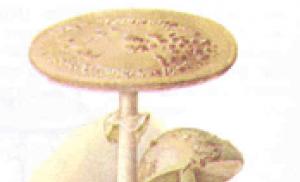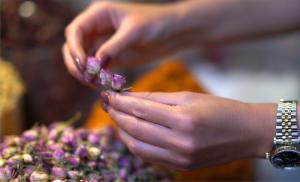Julia Child culinary. Julia Child Recipes
And here is the woman to whom this film is dedicated - Julia Child, a French chef, writer and TV presenter who had an amazing thirst for life and forever changed the way Americans think about cooking.
“Julia made cooking fun. She threw food down from the altar. She awakened Americans' interest in all things French, especially French cuisine,” said Linda Carucci, culinary arts specialist at the Napa Nutrition Center.
Although Child knew virtually nothing about cooking at all until she was thirty, let alone French cuisine, her television show The French Chef, which aired in 1963, made her a celebrity.
She tore away the veil of mystery from the kitchen and taught to be attentive to different techniques and one's own taste, and all this with such carelessness and a sense of humor that the audience involuntarily relaxed and began to trust their own instincts and intuition. Julia could be clumsy, but when she dropped a chicken on the floor, then dusted it off and served it with aplomb, housewives understood that the main thing was not to achieve perfection, but to enjoy their own cooking.
Child often said that she owed her success, which came in the 60s, to time - it was then that travel and foreign cuisine came into fashion. Women's role in society was expanding, and President John Kennedy and his wife Jacqueline hired White House French chef Rene Verdon. For the fun-loving expert in the mysterious realm of French cuisine, the possibilities were vast.
Much of the rise of California cuisine in the 70s was due to Julia Child. Alice Waters, the celebrity chef and owner of Chez Panisse in Berkeley, said of her: “There is no doubt that her television shows and cooking classes prepared Americans for restaurant dining. And I am sure that her views on cooking (after all, she was also a Francophile) had a strong influence on me.”
Her success sparked an interest in all things culinary, including companies like Williams-Sonoma, which is now America's premier supplier of high-quality kitchen utensils. Chuck Williams, founder of Williams-Sonoma, credits the release of Julia's book, Mastering the Art of French Cooking, with a surge in sales of tureens, whisks and steamers.
“She changed the way we cook. I'm not talking about the soufflé recipe - she changed the way we cook. For example, we started cooking green beans for 15 minutes instead of an hour and a half,” says Williams, “now we care about how the food looks and tastes.”
Above all, Child was a supporter of the good life and culinary joys. The so-called "new cooking" (Nouvelle Cuisine), low-fat and low-cholesterol foods and politically correct calls for abandoning chemical fertilizers and raising poultry in natural conditions caused her unbridled joy.
“What’s the big deal if some birds walk in their own excrement?” - she reasoned at a press conference in San Francisco.
Julia McWilliams Child was born into a wealthy and educated family in Pasadena in 1912. However, her refined culinary tastes did not originate in a carefree childhood. Both the home cook and the cooks at Katherine Branson's school in Ross, where she attended from 1927 to 1930, prepared the colorless, overcooked and bland food typical of American cuisine at the time.
Accustomed to the services of maids and cooks, Child did not show the slightest interest in cooking in her youth. Tall, energetic, and prone to mischief, she was an avid tennis player and spent a lot of time outdoors. However, Child diligently led the life expected of a member of her class and graduated from Sophia Smith College.
Returning to Pasadena, she plunged into social life, and later moved to New York, where she worked in a large store as a public relations representative, but never found a husband or a worthy admirer.
Family and friends partly blamed Julia's loneliness on her height. Her romantic and culinary instincts were awakened by Paul Child, who was half a head shorter and ten years older. Paul Child was an artist who became a cartographer for the Office of Strategic Services during the war.
Julia, who worked for the same Office in 1943 in Sri Lanka, was fascinated by the social manners of Paul, who had lived for some time in France and was well versed in gastronomy and wine. The first years of their life together resembled a grandiose culinary expedition to Sri Lanka and China.
When they returned to the United States in 1946, “Paul married me, despite my inability to cook,” Julia told reporters.
The couple lived in Washington, DC. Having married a gourmet, the thirty-year-old bride had to study the art of cooking from the book “The Joys of Cooking.” When Paul was assigned to a diplomatic post in France, Julia developed an interest in the mysteries of French cuisine - an interest that would later lead to a revolution in American cooking.
Studying at the Cordon Bleu culinary school, private lessons with its chef Max Bougnard and, finally, friendship with two French women, Simone Bec and Louisette Bertholle, led the three friends to found an informal culinary school, the School of Three Gourmets ( L "Ecole des Trois Gourmandes). A few years later, the trio released a book that forever changed America's views on cooking - Mastering the Art of French Cooking (1961).
Child was 37 years old when she started learning to cook. But she has more than made up for lost time. After the release of the show "The French Chef" on Boston television, her name was on everyone's lips. Along with the stars of show business, her name has become a household name. When they wanted to compliment the hostess, they often said: “roast (stew / mousse / chocolate) just like Julia’s.”
Julia Child's husky voice and cheerful chatter captivated viewers and brought cooking programs a popularity that continues to this day. Her latest show was called Cooking with Chefs, which Julia co-hosted with her frequent co-host and collaborator, French chef Jacques Pepin. Their book “Julia and Jacques Cook at Home” (1999) remained on the bestseller list for several months, and later a TV series was made based on it.
Of her old friend, Pepin says: “she revealed [to the Americans] the secrets of French cuisine in very simple words and in a very American way - with great enthusiasm and delight. She was very strong personality, and I’m sure that through the small TV screen people felt how natural, true to herself and spontaneous she was.”
On July 23, 2003, President Bush awarded Julia Child the Medal of Freedom. She gave lectures, hosted television shows and wrote books even in recent years of her life when she started having health problems. She continued to be an enthusiastic supporter of the American Institute of Food and Wine, of which she was a founding sponsor, and of the International Culinary Association, which annually awards cookbook authors with the Julia Child Award. She was also one of the first and most ardent fans of Copia, the American food, wine and arts center in Napa founded by Robert Mondavi. The organization's luxury restaurant was named Julia's Kitchen in her honor. The restaurant contains some authentic items from Julia Child's kitchen in Cambridge, Massachusetts. However, most of the kitchen furnishings were transported to the Smithsonian Institution's National Museum of American History, where they were restored in every detail, down to the window curtains and the contents of the drawers.
Shortly before her 90th birthday, Julia moved to Santa Barbara, where she and her husband often spent the winter. There she settled in a progressive nursing home, in a unit for older people leading active lives, but, if necessary, could be transferred to a unit with care and assistance.
“Julia thought about everything many years ago,” explains Stephanie Hersh, who helped her in the nursing home, “she believes that it is selfish on the part of a person not to prepare for retirement in a timely manner.”
Once, when Julia was already over ninety, she was asked about her health (she always despised diets and adored butter). She replied that she had her own personal nutrition plan. She planned to eat everything, but in small portions, no additives or food on the go, but “a reasonable amount of good wine.”
Julia was always for delicacies and delicacies. In an interview in San Francisco, just days after the 1989 Loma Prieta earthquake, she was asked what lunch she would order if she knew it was the last day of her life. “Crabs, oysters, some kind of duck dish, asparagus... it doesn’t matter if it’s in season or not... some chocolate dessert and a bottle of wine with each dish,” she answered without any hesitation.

With husband Paul
Julia Child's kitchen on display at the National Museum of American History
Some interesting facts about Julia Child:
- Julia was nominated 8 times for the American television Emmy Award and was awarded 3 times.
- She beat breast cancer.
- Julia died two days before her 92nd birthday. The last dish she prepared was French onion soup.
A variety of rose named after Julia Child. The choice of this particular color is due to Julia’s love for butter.
Here are a couple of simpler recipes:
BAKED POTATOES WITH CREAM AND CHEESE
Ingredients:
2 kg red potatoes, peeled
4 tablespoons butter
1 cup grated Emmental or Gruyere cheese
1 1/4 cups whipping cream, room temperature
1/2 cup milk
Black pepper
Preparation:
Cut the potatoes into thin slices. Place the potatoes in a bowl and cover with cold water. Leave for at least an hour. Drain the water and dry the potatoes well. Preheat the oven. Grease a 25 x 20 cm pan with butter. Lay the potatoes in layers, after each layer add cheese, pepper and a little butter, repeat layer by layer until you run out of potatoes, sprinkle cheese on top and put butter. Heat the cream, very carefully!, until the oil begins to separate. Immediately pour the cream over the potato layers, covering half of the potatoes, adding milk if necessary.
Bake for 1.5 hours until the top is lightly browned. The cream should be absorbed into the potatoes so that they are tender, not too soft.
Remove from the oven and leave for another 10 minutes.
BOEUF BOURGUIGNON
(Beef stew)
Of all the methods in which beef is seared until browned and then slowly simmered in an aromatic liquid, boeuf bourguignon (beef Bourguignon) is the most famous. Dob, estofado and usually do not require browning and are much easier to prepare. To be technically correct, any recipe in which the meat is thoroughly seared before braising should be called fricasse; here we don't always differentiate between them because "stewing" is now a more common usage.
Sliced for stewing.
The better the meat, the better the stew. And although you can use meat that is more expensive or cheaper, you should adhere to the following. Half a kilogram of meat without bones and without fat will be enough for two people; for three, if the menu is intended to be extensive.
Best Choice: Rump/Posterior Lumbar
And further: the neck part of the beef carcass/thick edge
loin/sirloin
hip/rump
inner thigh
Cooking time.
Making a good beef stew takes 3-4 hours of slow simmering, depending on the quality and tenderness of the meat. If the meat was marinated before cooking, it will take less time. The stew can be cooked both in the oven and over an open fire; The oven is preferable because the oven heat is more even.
BOEUF BOURGUIGNON
BOEUF A LA BOURGUIGNONNE
Beef Bourguignon. [beef stew stewed in red wine with bacon, onions and mushrooms]
As with any well-known dish, there are many ways to prepare delicious beef Bourguignon. Well cooked, amazingly flavorful, this is undoubtedly one of the most... best dishes, ever cooked up by men, and of course it can become a staple at a dinner party. Luckily, you can make it entirely in advance, even a day in advance, and it will only become more flavorful as you reheat it.
Vegetables and wine.
Traditionally, boiled potatoes are served with this dish. It can also be boiled pasta with butter or rice. If you're craving vegetables, butter beans are your best bet. Serve the meat with the highest quality, young red wine, such as Beaujolais, Cou du Rhone, Bordeaux-Saint-Emilion or any other Burgundy wine.
For 6 persons.
| 170 g bacon | Remove the skin and cut the bacon into “ribbons” (6 mm thick and 3.8 cm long). Slowly simmer the skin and bacon for 10 minutes in 1.5 liters of water. Remove and dry. |
| Preheat the oven to 230C | |
|
Fry bacon in oil over medium heat for 2 to 3 minutes until lightly browned. Remove with a slotted spoon and place on a plate. Reheat the oil and fat until the fat is almost smoking before you start frying the beef. |
| 1.3 kg lean beef, cut into 5cm cubes | Pat beef dry with paper towels; raw meat will not brown. Fry in several batches, a few pieces at a time, in olive oil and bacon fat, until the beef pieces are well browned on all sides. Place the beef with the bacon. |
|
In the same fat, brown the vegetables. Discard the fat from the casserole. |
|
Return the beef and bacon to the casserole and sprinkle with salt and pepper. Then sprinkle with flour and shake to coat the beef on all sides with flour. Place the casserole, uncovered, in the middle of the preheated oven for 4 minutes. Turn the meat over and return to the oven for another 4 minutes. This way the flour will brown and the meat will be covered with a tender crust. Remove the casserole and reduce the oven heat to 160C |
|
Pour in the wine and enough stock to barely cover the meat. Add tomato paste, garlic, herbs and bacon rind. Bring to a boil on the stove. Then cover the casserole with a lid and place in the lower third of the preheated oven. Adjust the oven heat so that the liquid is barely simmering and leave for 3-4 hours. The meat is done when a fork pierces it easily. |
| While the meat is cooking, prepare the onions and mushrooms and set them aside until you need them. | |
| When the meat is soft enough, pour the contents of the casserole into the saucepan through a sieve. Rinse the casserole and place the beef and bacon back. Scatter the cooked onions and mushrooms over the top. | |
| Skim the fat from the sauce in a saucepan. Simmer the sauce slowly for another minute or two, skimming off any fat that comes to the surface. You should end up with 2.5 cups of sauce thick enough to coat the back of a spoon. If the sauce is too thin, let it simmer a little. If too thick, add a few tablespoons of broth. Check the salt carefully. Pour the sauce over the meat and vegetables. (*) up to this point you can prepare the dish in advance |
|
| Parsley sprigs. | If you are filing immediately: Cover the casserole and simmer the contents slowly for 2-3 minutes, stirring the sauce with the vegetables and meat several times. Serve in casserole or place on a plate with potatoes, pasta or rice around it, garnished with parsley sprigs. |
| If you serve a little later: When the dish has cooled to room temperature, cover the casserole with a lid and put it in the refrigerator. 15-20 minutes before serving, bring to a boil, cover and continue to simmer for about 10 minutes, occasionally stirring the meat and vegetables into the sauce. |
Add the onions and mushrooms to the casserole
Mrs Child was a key figure in popular cooking for more than 40 years. Americans knew and loved her as an emotional show host. "French Chef" and the author of several popular culinary manuals. She was also respected by culinary professionals for the clear and pedantic approach with which she taught American housewives the secrets of French cuisine.Mrs. Child underwent serious culinary training at the Cordon Bleu school in Paris, and then in 1951 she organized her own school in Paris, the School of the Three Gourmets ( L’ Ecole des Trois Gourmandes), where, together with the co-authors of the book (Simone Beck, Louise Bertol), she taught young American women classical French cooking.
Based on her teaching experience, Julia Child published Lessons in French Cooking in 1961 - by an American for Americans. She proved that French delights can be adapted to American reality.
1963 became a landmark year - Julia became the host of her own television show “The French Chef” ( The French Chef). A special emotional manner, courage (cutting a live lobster!) and the ability not to be afraid of mistakes conquered the American nation. So much so that the program continued until 2000.
Other books by Julia Child:
- The French Chef Cookbook (1968) – recipes from early television episodes, published in Russian as « Bon appetit ! Basics of classic French cuisine" (2011) .
- From Julia Child ’ s Kitchen (1975, 1978, 1979) - based on the broadcasts of these years.
- Cooking with Master Chefs And In Julia's Kitchen with Master Chefs (written in the mid-1990s). In the Russian version you will find the book "Julia Child Cooks With Celebrity Chefs" (2012) .
- Julia and Jacques Cooking at Home (1999)
- Julia ’ s Kitchen Wisdom (2000) – the quintessence of all the years of culinary experience. In Russian it came out as « Voila ! Culinary Wisdom from Julia Child" (2010, 2011).

About the book “The Art of French Cooking”
As Mrs. Child herself said: “Everyone can cook in the French style,” and she added, “with the right instructions.”. Its main goal is to provide such a comprehensive guide to the principles and techniques of cooking that the reader becomes an independent cook, understands the fundamentals, and does not “hold on” to recipe instructions.Some numbers:
- 1961 First edition on English is considered the most complete guide to classic French cooking.
- 1983 An expanded and revised edition, where the publishers took into account the popularity of kitchen appliances.
- 2012 The book is published in Russian: gift wrapping, 2 volumes and 1376 pages (!) - and this with a minimum of illustrations, of which there are only a hundred.
Features of the book: illustrations are given only for cooking techniques, recipes - without them. Each section contains groups united general principles, so it is important to read the introductory word to each group - the techniques in the recipes are not so detailed.
Nice features: Each recipe contains recommendations for wine - a truly French approach! All recipes are adapted, so you will find products for them at the market or in the supermarket.
Presentation from simple to complex influenced the structure of the book: in the first volume you will find simple recipes, and in the second - complex. As you might have guessed, the Desserts and Baking section is covered in Volume 2.
“Desserts and baked goods” – this is all the splendor of French desserts: sweet sauces and fillings, creams, mousses, cold desserts, sweet soufflés, fruit desserts. There are also tarts, crepes, clafoutis, cakes, desserts based on lady fingers cookies, babas and savarens - in total more than 110 recipes, including 7 classic cakes! Believe me, you will find new nuances even in apple pie.
Trying at least one recipe from the book is an honor for the home cook, an opportunity to participate in the spirit of the times and France. And it doesn’t matter whether you read the publication in English or Russian, the main thing is to approach the matter with love, as Julia Child herself did.
On August 15, 2004, the famous American chef and author passed away best books in Cooking by Julia Child.
Julia Child (before her marriage McWilliams) was born on August 15, 1912 in California. Julia studied at prestigious schools: Westrige School, Polytechnic School, The Branson School, and in 1934 she graduated from Smith College and moved to New York, where she worked as a copywriter. Realizing that she did not like this activity, she returned to her homeland, but in order to live, she needed money and Julia began writing articles for a local magazine.
During World War II, Child was able to work her way into the Office of Strategic Services, where she worked as a research fellow in the intelligence department. Thanks to her work, she met her future husband. Due to Paul Child's duties, they were forced to move to France. It was this circumstance that determined Julia’s “culinary destiny”.
When they arrived in Paris, the first thing they did was go to a cafe, where Child tried halibut and realized that she simply had to repeat this masterpiece. But she didn't know how to cook and didn't know French, so she enrolled in the most prestigious culinary school, where star chef Max Bunyar taught courses in English. Since poor Child did not know how to cook even a basic omelette, no one believed in her at the courses, and she slowly adopted the experience of the masters and learned from her mistakes. In the end, she was able to pass the final exam - albeit on the second try.
After completing culinary courses and having practiced well at home, Julia decided to try to open her own culinary school - the “School of Three Gourmets”. The courses were wildly popular in Paris, despite the fact that some skeptics, and perhaps envious people, predicted failure for the school. Soon, Child wrote a book about how difficult her relationship with cooking was, openly talking about how she studied and what mistakes she made. The Joys of Cooking was a bestseller.
10 years later, the book “Mastering the Art of French Cuisine” was published in America, in which chef Julia Child revealed the secrets of the kitchen and talked about her “culinary journey.”
In November 1961, her books were among the most sold-out, and Child began to be invited to various culinary programs. Russians are more familiar with Julia Child from the film “Cooking a Recipe for Happiness”, with Meryl Streep in the role of Julia.
Julia Child made a huge contribution to cooking; restaurants still serve dishes based on her recipes. Last year, Americans turned her birthday into a national holiday by organizing a French Cuisine Week based on Julia Child's recipes. The restaurants served the dishes that Julia loved to cook at special prices. This year, Julia Child's dishes are being served in Chicago, New York, Maine and other areas of the United States.
“Moskvichka” has collected for you 7 of Julia’s most “appetizing” recipes, using which you will surely surprise and delight your friends and guests.
1. Baked potatoes with cream and cheese
Ingredients:
Peeled potatoes
4 tablespoons butter
1 cup grated Emmental or Gruyere cheese
1 1/4 cups whipping cream, room temperature
Half a glass of milk
Black pepper
Cooking method:
Cut the potatoes into thin slices, place in a bowl and cover with cold water. After about an hour, drain the water and dry the potatoes. Layer the potatoes in a greased pan, adding pepper, cheese and a small amount of butter to each layer. Grease the top with butter and sprinkle with grated cheese. Heat the cream (until the oil begins to separate, pour the cream onto the layers of potatoes)
Bake until golden brown. It is necessary that the cream is absorbed into the potatoes, then it acquires a particularly soft and delicate taste.
2. Vegetarian stuffed peppers
Ingredients:
2 teaspoons olive oil
- 3 cloves of garlic
- 1/2 onion
- 2 pcs. dried tomatoes
- 1/2 pcs. bell pepper, chopped
- 1/2 cup breadcrumbs (rice, polenta (hominy) or other grain)
- 0.5 cans (200g) canned tomatoes, diced
- 1/4 teaspoon black pepper
- 1/2 teaspoon mustard powder
- 2 bell peppers, cut lengthwise into halves
- 1/4 cup grated mozzarella cheese
- fresh parsley
Cooking method:
Preheat the oven. Heat oil over medium heat, add onion and garlic, fry. Add dried tomatoes, chopped bell pepper and breadcrumbs, fry until peppers are soft. Add the canned tomatoes a little at a time, allowing the liquid to evaporate before adding more tomatoes. Then add pepper and mustard. Spoon the prepared mixture into the pepper halves, sprinkle grated cheese on top and bake in the oven for 10 minutes. You can sprinkle fresh parsley on top.
3. French salad
Ingredients:
1 can beans, rinsed and drained
- 1 cup chopped zucchini squash
- 8 mushrooms, chopped
- 4.5 cups assorted green salad
- 4 hard-boiled eggs, cut into 8 pieces
- 2 large tomatoes, chopped
- 12 pcs. black olives
- anchovies to taste
- 2 cans of tuna
- parsley, chopped
- balsamic vinegar (this is a special type of grape vinegar).
Cooking method:
Marinate beans, zucchini and mushrooms in balsamic vinegar for 20-30 minutes. Then serve the salad on a platter. Place the green salad mixture around the edges of the plates. Place beans in the center and decorate
marinated mushrooms and zucchini, also lay out tomatoes, eggs, olives, anchovies and tuna pieces. Top with a little more balsamic vinegar, sprinkle with parsley and serve.
Tip: Delicious with French bread fried in olive oil and chilled rose wine.
4. "Floating Island"
Ingredients:
8 egg whites
- 1 teaspoon vanilla extract
- 2 glasses of milk
- 1 glass of sugar
- salt
- creamy vanilla sauce
Cooking method:
Boil milk in a saucepan over medium heat. Then turn the heat down to low. Preheat the oven. Beat the whites with a mixer until foamy. Add a pinch of salt and beat for a couple more seconds. Continuing to beat, add sugar and vanilla, adding sugar a little one spoon at a time. Using a tablespoon, carefully pour the egg white into the milk, leave for 2 minutes, stir a little and leave for 2 minutes again. Remove the whites from the milk. Bake in the oven for 20 minutes. The whites will rise, so we need a deep baking dish. Let the meringue cool for half an hour and put it in the refrigerator for 2-3 hours.
To serve, add caramel and creamy vanilla sauce. This way the whites will be a floating island in a sea of creamy vanilla sauce.
5. Charlotte by Julia Child
Ingredients:
6 apples (best golden)
- 0.5 cups of dried apricots, pureed through a sieve (it’s wiser to use a blender)
- 1 glass of sugar
- 2 teaspoons vanilla extract
- 1/4 cup dark rum
- 3 tbsp. spoons of butter
- 10-12 slices of homemade bread
- 1 cup melted butter
- 0.5 cups of pureed dried apricots
- 3 tbsp. spoons of rum
- 2 tbsp. spoons of sugar
Cooking method:
Cut the apples into 4 parts, remove the skin and cut into slices. Place the apples in the pan, cover with a lid and simmer over low heat for about 20 minutes, stirring occasionally. Add chopped dried apricots to apples,
sugar, vanilla, rum and butter. Turn up the heat and simmer, stirring constantly, for 20 minutes or more until all the liquid has evaporated. You should end up with a thick puree that holds a spoon.
Preheat the oven.
Cut off the crusts from the bread. Cut into squares and 4 semicircles, we need the bottom of the mold to be completely covered. Pour 3-4 tbsp over the bread. spoons of melted butter. Place the pieces of bread on the bottom of the pan.
Cut the remaining bread into strips. Place it in the melted butter, stir and place the pieces of bread tightly together in the pan. Now spread the applesauce on top, place it in the middle like a dome (when it cools down, it will fall down on its own).
Top with 4-5 strips of bread. Pour any remaining melted butter around the edges of the pan.
Place the pan in a saucepan (the oil will splatter there) and bake on the middle rack of the oven for about 30 minutes. Run a knife between the bread and the sides of the pan; if the bread turns golden brown, the charlotte is ready.
Remove from oven and cool for 15 minutes. Turn the mold over and place the charlotte on a plate.
6. Clafoutis
Ingredients:
1 1/4 cups milk
- 1/3 cup sugar
- 3 eggs
- 1 tablespoon vanilla
- 1/8 teaspoon salt
- 1/2 cup flour
- 3 cups pitted cherries
- 1/3 cup sugar
- powdered sugar
Cooking method:
In a blender, mix milk, sugar, eggs, vanilla, salt and flour. Pour a portion of the dough, about a centimeter high, into the greased pan. Place in the oven until lightly baked.
We take out the mold and place the cherries on the dough. Sprinkle cherries with 1/3 tbsp. Sahara. Pour the rest of the dough on top. Bake in the oven for 45 minutes to an hour. The clafoutis is ready when a knife comes out clean.
Sprinkle powdered sugar on top and serve warm.
7. Danish almond glaze
Ingredients:
1 cup almonds
- 1/2 cup powdered sugar
- 2 tablespoons butter at room temperature
- 1/2 tsp. almond extract
- 1 egg white, lightly beaten (large egg)
Cooking method:
Place almonds, sugar and butter in a food processor. Grind until the almonds are finely ground. Add almond extract and two tablespoons of beaten egg white. Mix everything with a mixer. Store in an airtight container in the refrigerator until needed (can be stored for about a week). Bring to room temperature before use.
The most famous American chef was the connoisseur of French cuisine, Julia Child. During World War II, she worked in intelligence to develop anti-shark poison, a drug that would repel sharks from sea mines. It is unknown whether her interest in cooking awoke at that time.
Finding herself in France after the war, she attended courses at the most prestigious culinary school in Paris, Cordon Bleu, and then, together with two friends, founded the American culinary school “School of the Three Gourmets.” Julia Child's Mastering the Art of French Cooking is an international bestseller. Meryl Streep won a Golden Globe for Best Actress for her role as Julia Child in Julie & Julia (2009).
Provençal roast with white wine
The classic Provencal roast beef is prepared with red wine, but you can adapt this recipe to white wine, which brings out the flavor of the gravy. And the gravy can be used perfectly as a sauce for pasta.
Ingredients:
- 4 tablespoons olive oil
- 2 tablespoons brandy or cognac
- 2.5 kg boneless beef, cut into small pieces
- salt and ground black pepper
- 2 large onions, thinly sliced
- 4 carrots, thinly sliced
- 150 g mushrooms, finely chopped
- 1 head of garlic, divided into cloves, crushed with a garlic press
- zest of 1 orange
- 2 tomatoes or 1 cup tomato puree
- 2 bottles of white wine
- a small bunch of parsley, 6-8 stalks of fresh thyme and 2 bay leaves (all spices can be tied into a bunch and then removed from the finished roast)
- 1/2 tablespoon whole black pepper (corns)
- 1/4 cup chopped parsley (for garnish)
- small pasta (as a side dish)
Marinate the meat with half the olive oil, cognac, salt and pepper for 2 hours. Preheat the oven to 160 degrees. In a heavy-bottomed saucepan, heat the remaining oil, add the onions, carrots, mushrooms, garlic, orange zest and 2 pinches of salt, fry, then reduce the heat, cover and simmer for 8-10 minutes until the onions and garlic are soft. Then add the beef along with the marinade, tomatoes, wine, a bunch of herbs and black pepper, stir. Cover with a lid and place in the oven for 3-4 hours. Serve hot with pasta.
Provençal tomato sauce

This base sauce can be frozen in small portions.
- 1/4 cup olive oil
- 2/3 cup finely chopped onion
- salt and pepper
- 4 teaspoons flour
- 2.5 kg tomatoes, quartered
- 1/8 teaspoon sugar
- 4 cloves garlic, crushed
- a bunch of aromatic herbs: 8 stalks of parsley, 1 bay leaf, 4 stalks of thyme (in a gauze bag)
- 1/4 teaspoon fennel seeds
- 1/2 teaspoon dried basil, oregano and marjoram
- 1 dozen coriander seeds, slightly crushed
- 1/2 teaspoon orange zest
- 2-3 tablespoons tomato paste
In a large deep frying pan, heat the oil over medium heat, add the onion, salt and simmer slowly for 10 minutes, it should not caramelize. Sprinkle with flour and fry over low heat for another 3 minutes, stirring. Using a coarse grater, grate the tomatoes until the puree becomes “grainy.” Add tomato puree, sugar, garlic, bunch of spices, fennel seeds, basil, coriander, orange zest and a teaspoon of salt to the pan. Cover and simmer for 10 minutes to allow the tomatoes to release their juice. Then open the lid and simmer slowly for about an hour until the sauce thickens. Remove the bag of herbs, add salt if necessary, add pepper, sugar and tomato paste and simmer for another 2 minutes. The sauce can be used immediately or frozen.
Berry clafoutis

An elegant and very simple recipe. The main thing is fresh berries. Clafoutis should be served warm. You don't have to use blueberries - any seasonal berries will do.
Ingredients:
- butter for greasing the mold
- 1 and 1/4 cups 2% milk
- 2/3 cup granulated sugar
- 3 eggs
- 1 tablespoon vanilla extract
- 1/8 teaspoon salt
- 1 cup flour
- 2 cups berries, washed and dried
- powdered sugar
Preheat the oven to 160 degrees. Lightly grease a baking dish. Place the milk, 1/3 cup granulated sugar, eggs, vanilla, salt and flour in a mixing bowl. Beat for about 1 minute until smooth. Pour a 5-7 mm layer of dough onto the bottom of the mold, wait 1-2 minutes until the dough layer “takes up”. Remove pan from oven. Place the berries on top and sprinkle with the remaining granulated sugar. pour in the remaining dough and level the surface. Return the pan to the oven and bake for about 50 minutes. Dust the clafoutis with powdered sugar before serving. Serve the clafoutis warm.
Today I want to invite you to prepare a light, delicate cream soup based on vegetables according to the recipe of the famous Julia Child. It is easy and quick to prepare, and most importantly, it does not require a lot of time, effort and money.
In fact, I cook fish quite rarely, but not because we don't like it. We don't have a large selection at all. And then one of Julia Child’s recipes caught my eye. After experimenting a little and making it my own, I ended up with a wonderful fish soufflé that is not difficult to prepare and is perfect for dinner and lunch.
Ratatouille is not only a cartoon character, but also a dish of French, or rather Provençal, cuisine, one of the varieties of vegetable stew. The main ingredients that Julia Child used in this recipe are zucchini, tomatoes, peppers and eggplant. But you can experiment with other vegetables if you like. You can also add more different seasonings.
Tarts are my weakness. And this one turned out absolutely delicious! I made it according to Julia Child's recipe. By the way, she suggests serving it hot. And for good reason - it tastes even better hot than cold. Main secret The extraordinary taste of this tart is due to the properly prepared dough. I changed the recipe a little, but this, in my opinion, only benefited it.
Of course, this dish should be prepared from a rooster, but, as for me, no one will figure out in the store where the rooster is and where the chicken is. Therefore, we take a regular chicken and start cooking. I read this recipe in Julia Child's book. Its highlight is the sauce! One of its main ingredients is wine. Actually, this is where the name of the dish comes from.
Many housewives liked Julia Child's recipes, which is why they often look for where to download her book “Mastering the Art of French Cooking.” So I decided to post a link to the file with the book here. True, it is in English, but I have already translated many of the recipes and posted them on this blog with photographs showing the whole process in detail. Here you will find links to them.
For some reason, many children do not like boiled onions. But over time, this dislike goes away. And some even prepare various dishes from boiled onions. And not just those in which it comes across here and there, but dishes in which onions are the main ingredient. That's how it is in this soup. I want to say right away that it will take you a lot of time to prepare it. And the dish turns out to be specific. So you’re unlikely to cook it often, but to surprise your guests...













